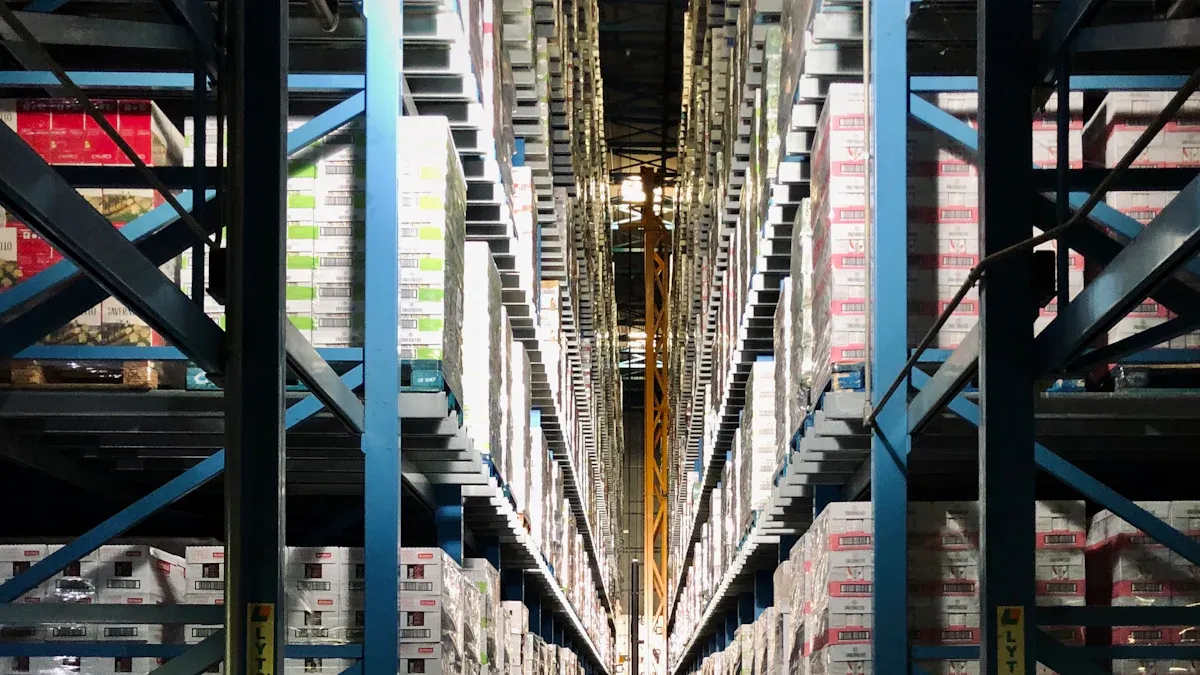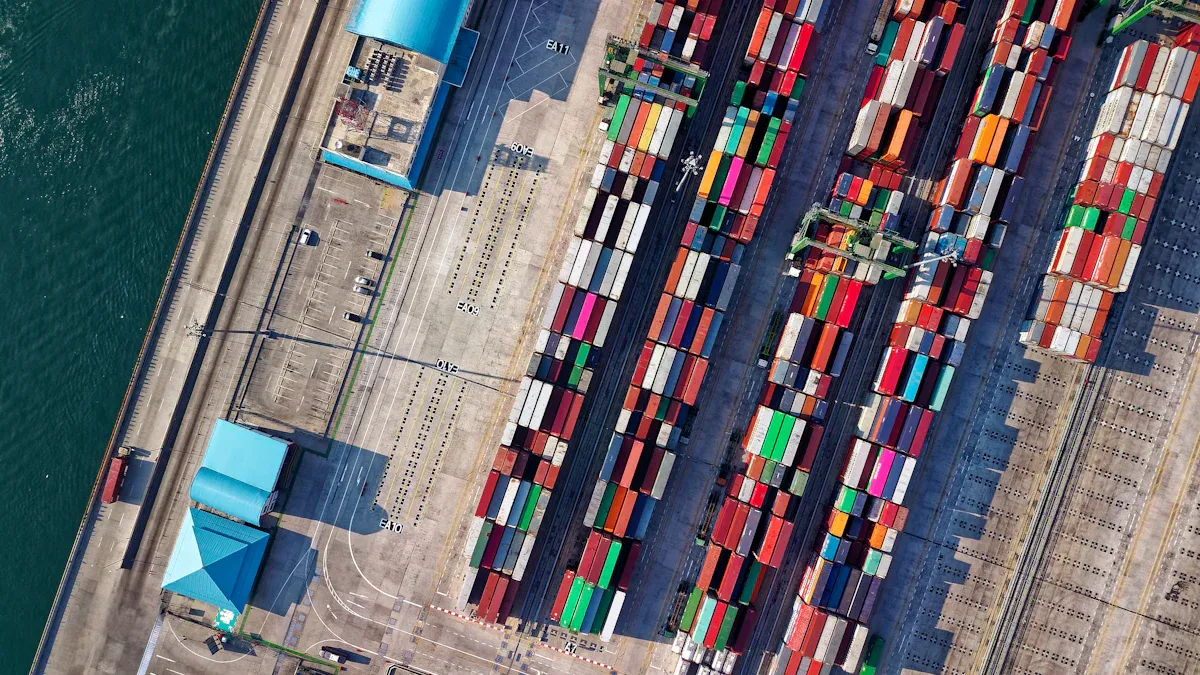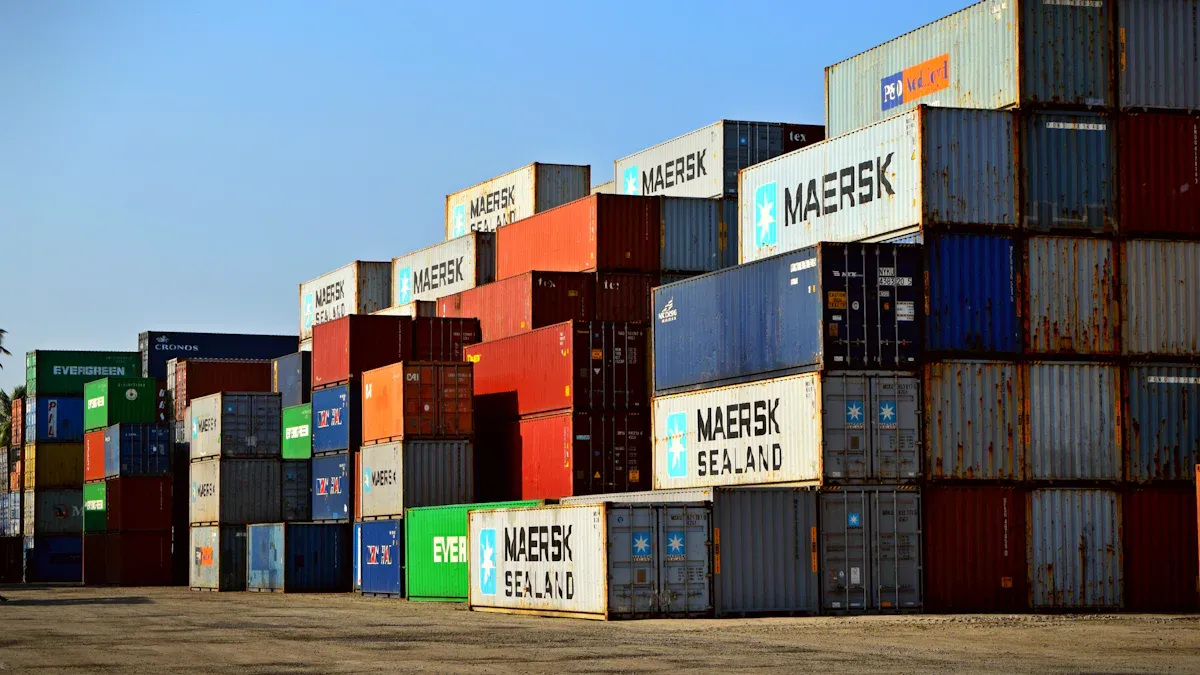How Urban Distribution Centers Are Transforming India's Supply Chain

Urban distribution centers are reshaping supply chains in India by prioritizing logistics efficiency and addressing last-mile deliveries. These hubs play a vital role in meeting the demands of a rapidly growing e-commerce sector, which is expected to expand from USD 66.76 billion in 2021 to USD 197 billion by 2027. Similarly, India's retail market is projected to reach USD 1.6 trillion by 2026. As consumer behavior evolves, businesses are investing in specialized delivery networks and micro-fulfillment centers to ensure efficient delivery and reduce delays. This shift is having a profound impact on urban logistics and supply chain operations.
Key Takeaways
City distribution centers make deliveries faster and more efficient. They help improve last-mile delivery for India's growing online shopping market.
These centers link rural workers to city buyers. This helps create more jobs in villages and raises farmers' earnings by 20-25%.
Problems like expensive land and weak infrastructure make building these centers hard. Creative ideas are needed to solve these issues.
Using smart tools like IoT and AI can make city logistics work much better.
Teamwork between government and private companies, along with new rules, is key to building better logistics systems and supporting eco-friendly methods.
Understanding Urban Distribution Centers and Their Role in Urban Logistics

What Are Urban Distribution Centers?
Urban distribution centers are specialized facilities located within or near cities. These hubs streamline the movement of goods by acting as intermediary points between suppliers and consumers. They play a critical role in urban logistics by ensuring that goods are stored, sorted, and dispatched efficiently to meet the demands of urban markets. With the rapid growth of e-commerce and retail sectors, these centers have become essential for addressing last-mile delivery challenges and reducing delivery times.
India's urbanization rate, which stood at approximately 35% in 2018, highlights the country's evolving urban landscape. As cities expand, urban distribution centers contribute to improving logistics networks, enhancing urban accessibility, and supporting the integrated supply chain. These centers are pivotal in connecting rural producers to urban consumers, ensuring seamless distribution and accessibility in urban markets.
Key Features of Urban Logistics Hubs
Urban logistics hubs are designed to optimize the flow of goods within cities. They possess several key features that enhance their functionality and efficiency:
Total Area: These hubs are strategically designed to maximize storage and operational capacity within limited urban spaces.
Handling Capacity: High handling capacity ensures that goods are processed and dispatched quickly to meet consumer demands.
Client Branches: Logistics hubs often cater to multiple client branches, enabling efficient distribution across various urban markets.
Transport Processes: These hubs manage diverse transport processes, including road, rail, and air, to ensure seamless connectivity.
Transport Volume: High transport volumes are managed effectively to meet the growing demands of urban logistics.
By incorporating these features, urban logistics hubs enhance connectivity and accessibility, making them indispensable for modern supply chains.
The Importance of Urban Distribution Centers in India's Supply Chain
Urban distribution centers are transforming India's supply chain by bridging the gap between rural producers and urban consumers. These logistics hubs serve as vital links, ensuring that goods reach urban markets efficiently. A World Bank analysis highlights the significant impact of improved logistics infrastructure, noting that it can increase rural employment by up to 15%. Additionally, farmers connected to effective logistical networks experience revenue increases of 20-25%, fostering rural prosperity.
The role of urban distribution centers extends beyond economic benefits. They enhance urban accessibility by reducing delivery times and improving the overall efficiency of supply chains. By supporting the integrated supply chain, these hubs enable businesses to meet the demands of India's rapidly growing e-commerce and retail sectors. As urban markets continue to expand, the importance of these centers in shaping India's logistics landscape cannot be overstated.
Challenges in Establishing Urban Distribution Centers in India
Infrastructure and Space Constraints in Urban Areas
Urban areas in India face significant challenges related to infrastructure and space availability. Rapid urbanization has led to overcrowding, leaving limited room for logistics hubs. Slums occupy a substantial portion of urban housing, highlighting the severity of space constraints.
Slums account for 25% of all urban housing in India.
In Mumbai, over 50% of the population resides in slums.
Approximately 25% of urban residents live below the poverty line.
The slum population, which was 41 million in 2001, reached an estimated 69 million by 2017.
Urban infrastructure suffers from poor governance, weak finances, and critical shortages.
These factors make it difficult to find suitable locations for urban distribution centers. The lack of adequate infrastructure further complicates logistics operations, leading to inefficiencies in supply chains.
High Real Estate Costs and Regulatory Hurdles
Real estate costs in urban areas remain a significant barrier to establishing distribution centers. Prime locations in cities like Mumbai, Delhi, and Bangalore command exorbitant prices, making it challenging for businesses to secure affordable spaces. Regulatory hurdles add another layer of complexity. Lengthy approval processes and inconsistent policies across states delay the establishment of logistics hubs. These challenges discourage investment and slow the development of efficient urban supply chains.
Limited Adoption of Advanced Technology in Urban Logistics
The adoption of advanced technology in urban logistics remains limited, despite its potential to revolutionize supply chains. Many businesses still rely on traditional methods, which lack the efficiency and scalability required for modern logistics. However, some companies are making strides toward technological integration.
The growing focus on electric vehicles (EVs) and renewable energy indicates a shift toward sustainable logistics. Companies like Flipkart and Amazon are leading the way by committing to EV adoption. However, widespread implementation of such technologies remains a challenge due to high costs and limited infrastructure support.
Addressing Traffic Congestion and Urban Planning Issues
Traffic congestion remains one of the most pressing challenges in India's urban areas. Rapid urbanization and population growth have led to an exponential increase in vehicles on the road. This surge has overwhelmed existing infrastructure, causing severe bottlenecks in transportation networks. Urban planners face significant hurdles in designing efficient systems that can accommodate the growing demand for mobility.
The studies highlight various dimensions of these impacts, including economic, health, environmental, and social aspects, which are critical for urban planning. The findings emphasize the pervasive impact that business traffic has on the lives of the public, affecting economic productivity, health issues due to stress and pollution, environmental degradation, and social fabric erosion.
Urban distribution centers play a pivotal role in addressing these challenges. By strategically locating these hubs near urban markets, businesses can reduce the number of vehicles required for last-mile deliveries. This approach minimizes traffic congestion and lowers carbon emissions. For instance, consolidated shipments from these centers ensure fewer trips, which alleviates the strain on urban roads.
Efficient urban planning must also incorporate sustainable practices. The integration of electric vehicles (EVs) and renewable energy solutions in logistics operations can significantly reduce pollution levels. Companies like Flipkart and Amazon have already committed to deploying thousands of EVs in their delivery fleets. These initiatives not only support environmental goals but also align with the broader objectives of urban planning.
Collaboration between public and private sectors is essential for long-term solutions. Governments must invest in smart traffic management systems and infrastructure upgrades. Meanwhile, businesses should adopt innovative technologies to optimize delivery routes and schedules. Together, these efforts can transform urban logistics, making cities more livable and sustainable for future generations.
Solutions to Overcome Challenges in Urban Logistics
Leveraging Technology for Smarter Urban Logistics Hubs
Technology plays a transformative role in addressing urban logistics challenges. Smart logistics hubs equipped with advanced technologies like IoT, AI, and big data enhance operational efficiency and reduce delays. These innovations enable real-time tracking, predictive analytics, and optimized route planning, ensuring faster deliveries and better resource management. For instance, AI-driven demand forecasting helps logistics hubs anticipate peak periods, allowing them to allocate resources effectively.
A study of contextual factors highlights the impact of technology adoption on logistics hubs. Positive drivers include GDP growth, R&D expenditure, and urban population expansion. However, the size of urban areas can hinder the implementation of 4.0 technologies.
Impact on Investment in 4.0 Technologies | |
|---|---|
GDP | Positive driver for new CL projects |
R&D Expenditure | Significant driver |
Employment Rate | Significant driver |
Urban Population | Significant driver |
Size of Urban Areas | Jeopardizes growth for 4.0 CL initiatives |
Level of Economic Development | Positively drives implementation |
By leveraging these technologies, logistics hubs can improve connectivity and accessibility, making urban logistics more efficient and sustainable.
Public-Private Partnerships for Infrastructure Development
Public-private partnerships (PPPs) offer effective solutions for overcoming infrastructure challenges in urban logistics. These collaborations pool resources and expertise from both sectors to develop modern logistics hubs and transportation systems. Successful PPPs have demonstrated their potential to address urban infrastructure gaps.
For example, the Delhi International Airport Limited project showcased the success of PPPs in creating world-class infrastructure. Similarly, the Tata Mundra Ultra Mega Power Project highlighted the ability of PPPs to tackle large-scale challenges, despite requiring contract renegotiations.
Case Study | Description | Outcome |
|---|---|---|
Delhi International Airport Limited | A major airport project showcasing public-private partnership success | Spectacular development with associated land use controversy |
Tata Mundra Ultra Mega Power Project | A significant power project under PPP | Renegotiation of contracts due to challenges faced |
These examples underline the importance of PPPs in developing logistics hubs that enhance urban connectivity and support economic growth.
Policy Reforms to Support Urban Distribution Centers
Policy reforms are essential for fostering the growth of urban distribution centers. Streamlined regulations, tax incentives, and land-use policies can encourage investment in logistics hubs. The warehousing sector, valued at $12.2 billion in 2022, is projected to grow to $34 billion by 2027, driven by policy support and rising e-commerce demand.
Reforms that prioritize sustainable practices and innovation will further strengthen urban logistics. Policymakers must focus on creating a conducive environment for logistics hubs to thrive, ensuring long-term benefits for businesses and consumers alike.
Innovative Space Utilization and Sustainable Practices
Urban distribution centers in India face significant challenges due to limited space and high real estate costs. Innovative solutions are transforming these hubs into efficient logistics facilities that maximize space utilization while promoting sustainability. Businesses are adopting creative strategies to optimize operations and reduce environmental impact.
Vertical Warehousing and Compact Designs
Vertical warehousing is revolutionizing logistics hubs by utilizing vertical space for storage. Multi-story warehouses equipped with automated systems allow businesses to store more goods in smaller areas. Compact designs further enhance efficiency by minimizing unused space and streamlining workflows. These approaches reduce the need for expansive facilities, making them ideal for urban environments.
Shared Logistics Facilities
Shared logistics facilities offer a collaborative solution for space constraints. Multiple businesses use the same distribution center, sharing resources and reducing costs. This model improves efficiency and fosters partnerships among companies. Shared facilities also minimize the environmental footprint by consolidating operations and reducing redundant infrastructure.
Sustainable Practices in Urban Logistics
Sustainability is becoming a priority for urban distribution centers. Green building designs incorporate energy-efficient lighting, solar panels, and rainwater harvesting systems. Electric vehicles are replacing traditional delivery trucks, reducing carbon emissions. Waste management systems ensure that packaging materials are recycled or reused, contributing to a circular economy.
Tip: Businesses can integrate smart technologies like IoT and AI to monitor energy consumption and optimize resource usage, further enhancing sustainability.
Real-World Applications
Companies like JUSDA are implementing innovative solutions to address space and sustainability challenges. JUSDA's logistics hubs in Bangalore, Hyderabad, and Pune utilize advanced technologies to optimize space and streamline operations. Their focus on sustainable practices aligns with global trends, setting a benchmark for urban logistics in India.
By adopting these solutions, urban distribution centers can overcome space constraints and contribute to a sustainable future. These practices not only improve operational efficiency but also support India's broader environmental goals.
Real-World Examples and JUSDA's Role in Urban Logistics

Case Studies of Successful Urban Distribution Centers in India
India's urban logistics landscape has seen remarkable transformations through the establishment of efficient logistics hubs. For instance, Delhi's Okhla Industrial Area serves as a prime example of a successful urban distribution center. Strategically located near urban markets, it facilitates seamless movement of goods across the city. Its proximity to major transport corridors ensures reduced transit times and improved connectivity. Similarly, the Bhiwandi logistics hub near Mumbai has revolutionized supply chains by serving as a critical node for e-commerce giants. These hubs demonstrate how strategic placement and operational efficiency can address the growing demands of urban markets.
How JUSDA in Indian Market Is Addressing Supply Chain Challenges
JUSDA has emerged as a key player in India's logistics sector by addressing critical supply chain challenges. Its logistics hubs in Bangalore, Hyderabad, and Pune cater to mid-to-high-end electronic component suppliers. These hubs provide bonded warehouse services, ensuring smooth customs processes and efficient storage solutions. JUSDA's inland transportation services further enhance connectivity by facilitating timely delivery of goods to urban markets. By integrating advanced digital systems, JUSDA streamlines operations, reduces delays, and improves service quality. This approach not only optimizes supply chains but also supports businesses in navigating India's complex logistics environment.
Emerging Trends in Urban Logistics and JUSDA's Innovations
Urban logistics is evolving rapidly, driven by technological advancements and innovative practices. JUSDA has embraced emerging trends to enhance its logistics hubs and operations. The adoption of IoT and telematics technologies enables real-time tracking and route optimization, improving operational efficiency. Autonomous vehicles are reducing delivery times and addressing driver shortages, while investments in multimodal transport corridors facilitate seamless movement of goods.
Trend Description | Impact |
|---|---|
Adoption of IoT and telematics | Enables real-time tracking, route optimization, and predictive maintenance. |
Emergence of autonomous vehicles | Reduces delivery times and mitigates driver shortages. |
Investments in multimodal corridors | Improves connectivity and reduces transit times. |
JUSDA's focus on these innovations positions it as a leader in urban logistics. By leveraging technology and sustainable practices, JUSDA continues to set benchmarks in the industry, ensuring efficient and eco-friendly supply chains.
Urban distribution centers are revolutionizing India's supply chain by enhancing logistics efficiency and reducing costs. These hubs improve last-mile deliveries and ensure efficient delivery to urban markets. Their impact extends beyond economic benefits, fostering better connectivity and accessibility in cities. JUSDA's innovative solutions demonstrate how advanced logistics hubs can address supply chain challenges effectively. Continued investment in technology and infrastructure will further strengthen India's logistics network. Urban distribution centers will play a pivotal role in shaping the future of India's supply chain.
FAQ
What challenges do businesses face when establishing urban distribution centers?
Businesses encounter high real estate costs, space constraints, and regulatory hurdles. Traffic congestion and limited adoption of advanced technology further complicate logistics operations in urban areas.
How does technology improve urban logistics hubs?
Technology like IoT and AI enhances efficiency by enabling real-time tracking, predictive analytics, and optimized route planning. These innovations reduce delays and improve resource management.
What role does JUSDA play in India's urban logistics?
JUSDA addresses supply chain challenges through bonded warehouse services, inland transportation, and digital systems. Its hubs in Bangalore, Hyderabad, and Pune optimize operations and improve service quality for electronic component suppliers.
See Also
Transforming Industries Through Cloud-Based Supply Chain Solutions
The Future of Logistics: AI-Driven Supply Chain Solutions
Improving Supply Chains Using Cloud Technology Innovations
Supply Chain Innovations That Are Transforming Logistics Today
Boosting Efficiency Through Innovative AI Supply Chain Solutions
